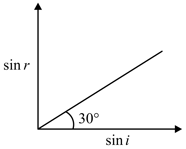Polaroids can decrease the intensity of light.
Important Questions on Wave Optics
As shown in figures, three identical polaroids , and are placed one after another. The pass axis of and are inclined at angle of and with respect to axis of . The source has an intensity of . The intensity of light at point is _____.

Unpolarised red light is incident on the surface of a lake at incident angle . An observer seeing the light reflected from the water surface through a polariser notices that on rotating the polariser, the intensity of light drops to zero at a certain orientation. The red light is replaced by unpolarised blue light. The observer sees the same effect with reflected blue light at incident angle .
Then,
How will you distinguish experimentally between ordinary light and plane-polarized light?
A transparent medium shows relation and as shown. If the speed of light in vacuum is the Brewster angle for the medium is

| Column I | Column II | ||
| Interference | Coherent sources | ||
| Brewster's Law | |||
| Malus Law | |||
| Total Internal reflection |

